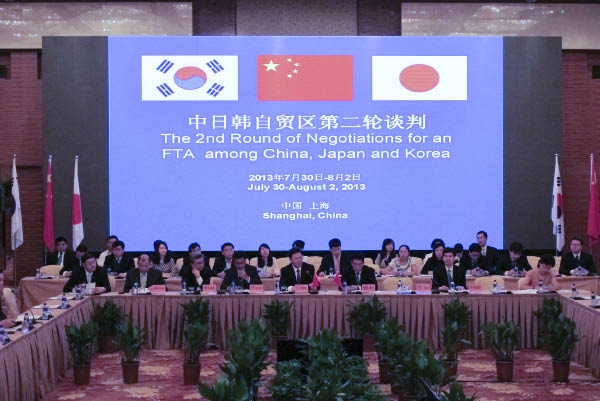Free Trade Area of the Asia-Pacific in Prospect
The second round of negotiations for an FTA among China, Japan and Korea was held in Shanghai from July 30 to August 2, 2013.

Many Difficulties, but More Solutions
In recent years, the slow revival and outdated development modes of the Asia-Pacific economy forced the region to seek new modes of cooperation. The successful examples of other areas have boosted the integration of the Asia-Pacific region. However, APEC is at cross-roads, facing the awkward choice of fragmentation or economic integration.
The difficulties are as follows. The first is the different directions and priorities in regional economic cooperation. The 21 member states of APEC, in terms of geography, are located in North America, South America, East Asia and Oceania. They include developed industrialized and developing countries; capitalist and socialist countries; and they are further diversified in religion and culture. The diversity of its member states is the basis for APEC’s existence, as well as the premise that must be considered when formulating any guiding principles. Over the past 10 years, trade volume within Asia has increased from US $1 trillion to US $3 trillion, climbing from 30 percent to 50 percent of all Asian trade. However, compared with that of the EU, the gap is still huge.
The second is fragmentation and subregional interests. There are several culprits: some developed member states hold a negative attitude towards economic and technical cooperation and often operate on a unilateral basis. Although the Trans-Pacific Partnership (TPP) and Regional Comprehensive Economic Partnership (RCEP) are workable pathways to realize the FTAAP, some countries still act independently without coordinating with other members. Diversity within APEC is also an obstacle to cooperation. Political factors, including issues related to history, territory and culture clashes, also negatively affect cooperation. Moreover, recent years have seen diversified forms of free trade area worldwide. The free trade agreements within the Asia-Pacific region have seen rapid development. Although they are conducive to trade development, they still cause the “spaghetti bowl” effect of many differing agreements that make it difficult for enterprises to adapt to local conditions. For example, if different treatments are applied to the same product of an enterprise in different free trade areas, the requirements for their Certificate of Origin are also different. A Free Trade Area can end the “spaghetti bowl” effect that all APEC members are facing now.
The third obstacle is the shortage of feasible and workable mechanisms and funds for regional development.
Despite all of that, the progress of the FTAAP has entered a relatively mature stage. There are many difficulties ahead, but more solutions.
First of all, the revival of the Asia-Pacific economy, especially that of the economy of East Asia, provides huge market demand, capital reserve and convenience. APEC members are increasingly reaching consensus in fields where they had previously disagreed. The re-proposal of the FTAAP has won joint and active response from Asia-Pacific countries, including the U.S. and Japan. China proposes to promote the interaction of free trade areas such as TTP and RECP under the APEC framework and discuss and formulate the routes and patterns to realize the FTAAP. Feasibility studies shall be started as early as possible and the establishment of the FTAAP shall be launched, as is also suggested by China. The above proposals have won active response from relevant parties.
Second, APEC members have never stopped their endeavor in recent years and are very close to success. The member states have made commitments through their individual action plans. Since 1994 when the long-term goal was set, APEC has made progress in trade liberalization. However, investment liberalization is still confined to information exchange and policy dialogue. Under the impact of the financial crisis, APEC’s pace in promoting trade and investment liberalization slowed down in 1999, but the member states generally approved the goal of liberalization. In their individual action plans (IAP), member states have improved their measures to move towards trading goals. In 2000, APEC member states decided to adopt Electronic Individual Action Plans (e-IAPs), submitting and publicizing online the measures that member states adopt to facilitate and liberalize trade and investment. Thereafter slow progress has been made in APEC integration.
Finally, other regional integration organizations, such as the EU and North American Free Trade Agreement (NAFTA), have provided valuable experience. China proposes to establish a special work team to study the feasibility of the FTAAP.

